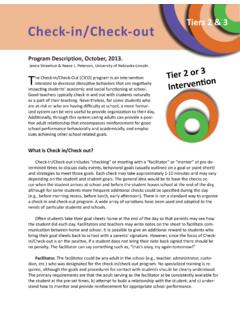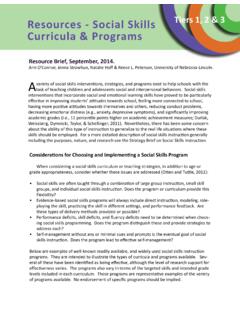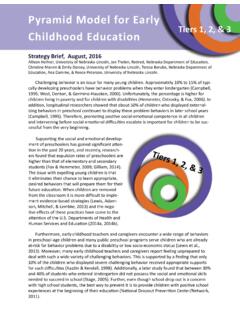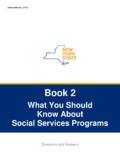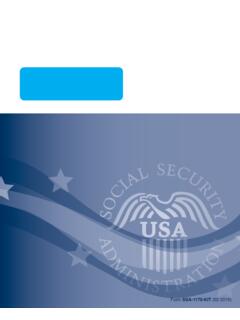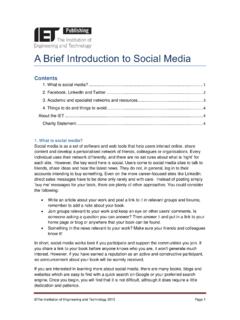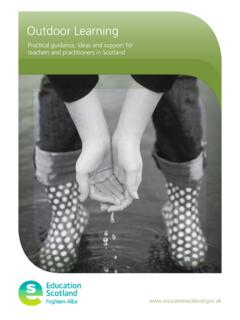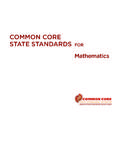Transcription of Social Skills Tiers 1, 2 & 3 Instruction
1 Social Skills InstructionTiers 1, 2 & 3ent Social contexts, and know appropriate behavior and communication Skills in a variety of situations. Social competence has been shown to have a long-term effect on psychological, academic, and adaptive functioning (Elliot, Malecki, & Demaray, 2001). Social Skills are one essential component of Social competence. They rep-resent the Skills which, if present, lead a person to be socially competent. Navigating everyday interactions can be especially difficult when a person has not learned Social Skills ; interactions with both peers and adults are hindered. According to Otten and Tuttle (2011), students with poor Social and behavioral Skills are at risk for a stag-gering number of problems that have a negative impact Having strong Social Skills is essential to a child s academic and personal success. These Skills guide children s everyday interactions and the extent to which they possess them can influ-ence what they say, how they behave, and even the choices that they make.
2 When children and adolescents struggle with Social Skills , they face challenges both inside and outside of the class-room. Social competence is the ability to obtain successful outcomes from interactions with others (Spence, 2003, p. 84) or Social functioning. Social competence requires students to adapt to differ-Strategy Brief, Septermber, 2014. Jenna Strawhun, Ann O Connor, Laura Norris & Reece L. Peterson, University of not only themselves, but society as well. Some of these problems include school dropout, depression, anxiety, substance abuse, delinquency, and aggression. According to Spence (2003), research evidence shows that Social skill deficits are associated with a wide variety of emotional and behavioral problems. Therefore, Social Skills Instruction is a frequent part of the prevention and treatment of these disorders (Spence, 2003). Typically K-12 education has presumed that students learn Social Skills informally from family and community experience as well as experiences in schools, and thus when a student does not demonstrate these Skills he or she was often punished.
3 However recently schools have begun to recognize that some students either have not been exposed to situations in order to learn so-cial Skills or simply have not learned these Skills . As a result schools have been moving toward assessing and providing Instruction Social Skills for all students, as well as providing remedial Instruction for those having skill deficits or difficulty with these Skills . Tier 1, 2 or 3 InterventionSocial Skills Instruction 2 What are Social Skills ? Social Skills are a set of competencies that allow an individual to initiate and maintain positive Social relationships, contribute to peer acceptance and a satisfactory school adjust-ment, and allow an individual to cope effectively with the larger Social environment (Steedly, Schwartz, Levin, & Luke, 2008, p. 2). Social Skills are specific, socially acceptable, learned behav-iors, which allow people to interact in positive ways and assist in avoiding negative responses from others (Cartledge & Milburn, 1995).
4 They are the Skills needed for productive, positive are Social Skills Curricula?There have been many efforts to identify the Social Skills individuals may need to success-fully interact in various situations. These essential Social Skills when combined into an organized structure are called a Social Skills curriculum. These curricula may be targeted to specific ages, or to specific situa-tions, but most often cover a wide range of possible Skills needed in day to day life. Al-though the intentional teaching of Social Skills has not been a strong focus for many schools given their focus on academics and the presumption that these Skills would be learned informally, many schools have now adopted school or district-wide Social Skills curricula, which are parallel to curricula in other areas such as math, reading, or sci-ence studies. A variety of Social Skills programs have also been pub-lished. Almost all include a curriculum, but some also include teaching strategies or activities and lesson a curriculum based on neurodevelopmen-tal principles that emphasizes self-control, emotional understanding, self-esteem, peer relations, and problem-solving.
5 The Second Step (Committee for Chil-dren, 2011) program has modules appropri-ate for preschool through middle school students that focus on teaching Social -emotional Skills , such as empathy, emotion management, and problem-solving. Skillstreaming (McGinnis, 2011) is a program that aims to improve aggression, withdrawal, and conflicts through modeling, role playing, performance feedback, and generalization. Stop and Think (Knoff, 2001), which uses role-playing and group activities to help students learn interpersonal, survival, problem-solving, and conflict resolution Skills . For more information on these and a few other examples of Social Skills pro-grams, see the Resource Brief entitled Examples of Social Skills Curricula described at the end of this document. What is Social Skills Instruction ? Social Skills Instruction is the deliberate effort by educators to teach Social Skills to students, typically based on an assessment of needed Skills , and then employing an identi-fied curriculum.
6 As with teaching any cur-ricula, there may be many differing strategies or methods for teaching Social Skills . It may be important for educators to provide explanations about the reasons the Skills are important (moti-vation), direct teaching of the Skills , opportuni-ties to practice with guidance, and independent practice, as well as positive feedback for im-provement. Social Skills Instruction 3have been used successfully in schools are listed here (no specific endorsement of these programs should be implied): A Curriculum for Children s Effective Peer and Teacher Skills (ACCEPTS: Walker et al., 1988) includes Social scripts involving making friends, classroom Skills , interaction Skills , and coping Skills that are all taught in a direct Instruction format. The EQUIP: Teaching Youth to Think and Act Responsibly Through a Peer Helping Approach (Gibbs, Potter, & Goldstein, 1995) program involves a tri-fold intervention encompassing training in moral judgment, anger management/correction of thinking errors, and prosocial Skills .
7 The PREPARE Curriculum: Teaching Prosocial Competencies (Goldstein, 1999) involves ten courses designed to reduce ag-gression, stress, and prejudice. Promoting Alternative Thinking Strate-gies (PATHS; Kusche & Greenberg, 1997) is plans. Some representative programs which Implementing Social Skills InstructionSocial Skills Instruction , or training, has traditionally been taught to students with emo-wide discipline that targets the entire school, classrooms, and individuals. An example of a school-wide, evidence-based program that includes effective Social Skills interventions is Positive Behavioral Interventions & Supports Social Skills Instruction 4tional, behavioral, and learning disorders (Maag, 2006), autism spectrum disorders, or other disabilities, but can be taught to student that would benefit from Instruction . Social Skills Instruction is implemented with students who need more intensive interventions to learn and practice Social Skills .
8 These supports can be modi-fied depending on how much guidance the student needs. According to Maag (2005), there is not just one interven-tion technique to train Social Skills , but many based on the child s pattern of deficits. Research on effective Social Skills Instruction suggests that quality interventions and strat-egies encourage reflection and self-awareness by focusing on Social and emotional learning (SEL) strategies. In addition, these techniques create oppor-tunities by practicing effective Social Skills , both individually and in groups, and allow for the adjustment of instructional strategies used to address the deficit. Finally, these strategies allow the educator to customize the interven-tion to address the specific needs of any student (Steedly et al., 2008). While Social Skills Instruction can be used to help individual students who may be at risk or already showing skill deficits, it can also be implemented in small or classroom wide groups, as well as at a school-wide level.
9 Using a preventive approach for all students can help Social and behavioral problems from develop-ing. Schools can use a systematic, integrated approach to Social Skills Instruction and school-(PBIS) [See strategy brief on PBIS]. As a part of this approach, Social Skills for various situations within a school are directly taught to students, modeled, and demonstrated. Social Skills are then reinforced when they occur (Positive Be-havioral Interventions and Supports, 2011). What Do We know About Social Skills Instruction ?In an analysis of six meta-analyses, Gresh-am, Cook, Crews, & Kern (2004) found a 64% improvement rate showing that Social Skills in- Social Skills Instruction 5struction is an effective intervention strategy for students with emotional or behavioral disorders. Also, analyses showed that Social Skills training is effective across a range of behaviors includ-ing external aggressive behaviors, internalizing behaviors, and antisocial behaviors (Gresham et al.)
10 , 2004). Gresham and colleagues do caution, however, that Social Skills training should not be used as a single intervention for students with emotional or behavioral disorders, but rather it should be one part of a comprehensive interven-tion program for these students. In another study with elementary age children, students received Instruction in Social Skills through small groups. Results of the study showed lasting decreases in disruptive behaviors at school and negative Social interactions on the playground. Students were also engaged aca-demically more of the time and demonstrated the newly acquired Skills in multiple settings (Lane et al., 2003). Effective Social Skills allow students to form healthy relationships and inter-actions. While it has been shown that Social Skills Instruction can have a positive effect on some students struggling with interpersonal relation-ships and behavior, there has been long-standing controversy surrounding the issue of gener-alization of Social skill Instruction (Beelmann, Pfingsten, & L sel, 1994; Singh Deitz, Epstein, & Singh, 1991).

